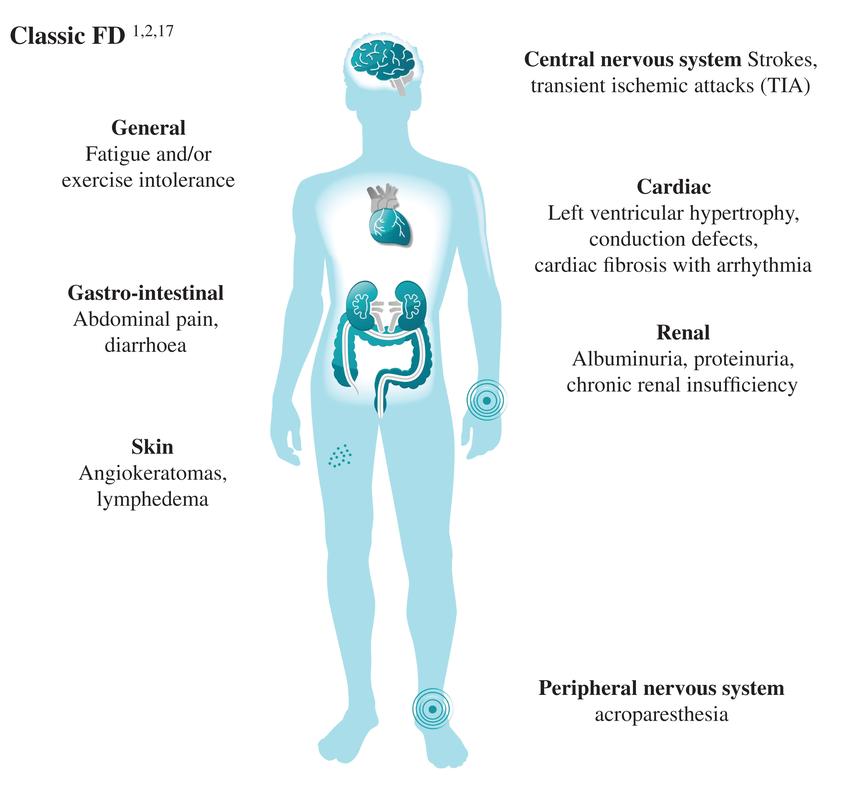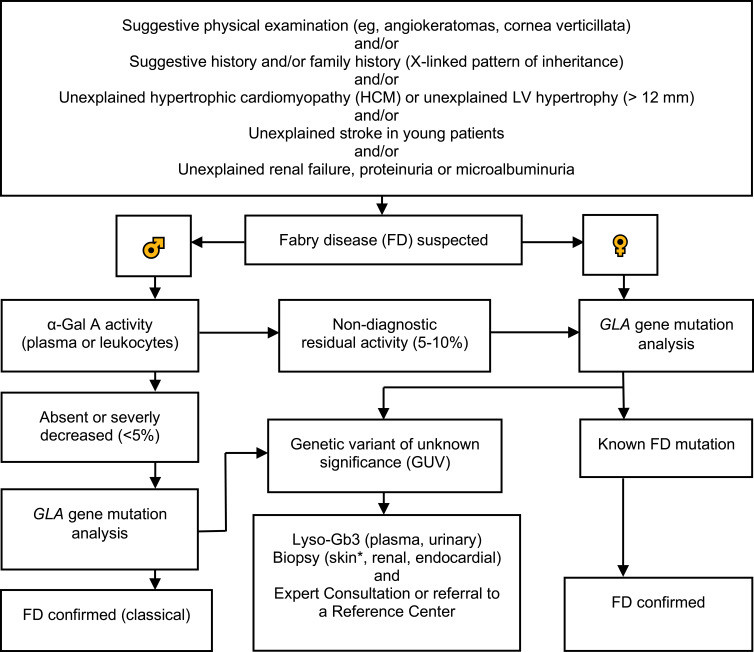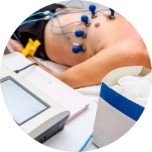Fabry disease (FD) is a multifaceted genetic disorder that demands comprehensive diagnostic strategies to overcome its diagnostic challenges. This resource provides an in-depth exploration of current and emerging diagnostic approaches, including enzymatic assays, biomarker testing, and genetic analysis, while addressing critical issues like gender disparities and organ-specific manifestations.
Introduction to Fabry Disease (FD)
Fabry disease (FD) is a rare, X-linked lysosomal storage disorder caused by mutations in the GLA gene, leading to deficient activity of the enzyme α-galactosidase A (α-Gal A). This results in progressive accumulation of globotriaosylceramide (Gb3) and its derivatives in cells, damaging vital organs such as the kidneys, heart, and nervous system. FD affects an estimated 1 in 40,000 to 1 in 117,000 live births worldwide, though recent newborn screening studies suggest it may be significantly underdiagnosed, with higher prevalence in certain populations.
 Fig.1 Main clinical manifestations of Fabry disease (FD). (Germain D P, et al., 2022)
Fig.1 Main clinical manifestations of Fabry disease (FD). (Germain D P, et al., 2022)
Diagnosis of Fabry Disease (FD)
Fabry disease (FD) diagnosis integrates biochemical, genetic, and clinical assessments due to its heterogeneous presentation. In males, reduced α-galactosidase A (α-Gal A) enzyme activity in leukocytes or dried blood spots provides initial confirmation, while females often require GLA gene sequencing due to normal enzyme levels. The biomarker lyso-Gb3 enhances diagnostic accuracy, particularly for atypical cases.
 Fig.2 Diagnostic algorithm for Fabry disease (FD). (Vardarli I, et al., 2020)
Fig.2 Diagnostic algorithm for Fabry disease (FD). (Vardarli I, et al., 2020)
Diagnosis of Cardiac Involvement
Cardiac complications are a leading cause of morbidity and mortality in Fabry disease (FD), affecting up to 60-70% of patients, including both classic and late-onset variants. The spectrum of cardiac manifestations includes left ventricular hypertrophy (LVH), arrhythmias, valvular dysfunction, and heart failure, often mimicking hypertrophic cardiomyopathy (HCM) or other storage disorders. The key diagnostic methods are as follows:
Imaging
Cardiac imaging is pivotal for detecting Fabry-related cardiomyopathy. Echocardiography reveals concentric left ventricular hypertrophy (LVH), while cardiac MRI (CMR) provides superior tissue characterization through late gadolinium enhancement (fibrosis) and quantitative T1 mapping (lipid accumulation). CMR is particularly valuable for early detection before hypertrophy develops.
Electrocardiography (ECG)
ECG abnormalities in FD often precede structural changes, with characteristic findings including short PR intervals (50% of cases), conduction defects, and arrhythmias. Progressive ECG changes correlate with disease severity, making serial monitoring crucial for risk stratification.
Biomarker Testing
Plasma globotriaosylsphingosine (Lyso-Gb3) levels strongly associate with cardiac involvement severity. Cardiac-specific biomarkers (high-sensitivity troponin, NT-proBNP) complement imaging by detecting subclinical myocardial injury and monitoring treatment response.
Genetic Testing
GLA gene sequencing is mandatory for confirming FD in patients with unexplained LVH, especially women and late-onset cases. Genetic testing enables family screening and differentiation from other hypertrophic cardiomyopathies, with certain variants predicting severe cardiac phenotypes.
Diagnosis of Renal Involvement
Renal complications in Fabry disease (FD) arise from globotriaosylceramide (Gb3) accumulation in podocytes, tubular cells, and vascular endothelium, leading to progressive kidney damage. Early diagnosis is critical to prevent end-stage renal disease (ESRD), which affects ~13% of male and ~2% of female patients by age 55. Some key diagnostic methods are listed below:

- Urine Analysis: Urinalysis is critical for early detection, typically revealing proteinuria and microhematuria. Quantitative measurement of urinary protein/creatinine ratio helps monitor disease progression. Elevated urinary Gb3 and lyso-Gb3 levels support diagnosis.
- Blood Tests: eGFR decline often precedes overt proteinuria, while rising creatinine indicates advanced damage. Plasma lyso-Gb3 levels correlate with renal involvement severity, particularly in classic FD.
- Renal Biopsy: Biopsy can show characteristic lamellar inclusions in podocytes by electron microscopy. Immunohistochemistry shows Gb3 deposition in renal cells. This test can be considered when clinical presentation is atypical or genetic testing results are inconclusive.
- Imaging: Renal ultrasound may reveal increased cortical echogenicity or cysts in advanced cases. Emerging MRI techniques can detect early lipid accumulation before functional decline occurs. Imaging primarily serves to exclude other causes of kidney disease rather than confirm FD.
Diagnosis of Neurologic Involvement
Neurologic manifestations in Fabry disease (FD) include small-fiber neuropathy, cerebral white matter lesions, and stroke-like episodes, often presenting before systemic complications. Diagnosis relies on clinical assessment, quantitative sensory testing, skin biopsy, and brain MRI. Plasma lyso-Gb3 levels may correlate with neurologic severity, while neurophysiologic studies (e.g., nerve conduction) often remain normal due to selective small-fiber damage. Early recognition is critical to prevent irreversible neurologic damage through timely enzyme replacement therapy.
Diagnostic Challenges of Fabry Disease (FD)
Fabry disease (FD) remains a frequently underdiagnosed and misdiagnosed X-linked lysosomal storage disorder due to its heterogeneous clinical presentation, which often mimics more common conditions such as chronic kidney disease, hypertrophic cardiomyopathy, or neuropathic pain syndromes. The diagnostic delay averages 13.7 years in males and 16.3 years in females, with many patients visiting multiple specialists before receiving a correct diagnosis9. Key challenges include:
- Gender disparities: Females, despite being symptomatic in up to one-third of cases, often exhibit normal or near-normal α-Gal A enzyme activity, necessitating genetic testing for confirmation.
- Late-onset variants: Non-classical phenotypes (e.g., cardiac or renal variants) may lack early symptoms, delaying diagnosis until irreversible organ damage occurs.
- Diagnostic limitations: While enzyme assays (α-Gal A activity) are reliable for males, Lyso-Gb3 biomarkers and genetic sequencing (GLA gene) are critical for females and atypical cases. Emerging biomarkers like urinary myeloid bodies show promise for early detection and therapy monitoring.
- Lack of standardized screening: Despite expert recommendations for family cascade screening, implementation remains inconsistent, particularly in asymptomatic at-risk relatives.
Future of Fabry Disease (FD) Diagnosis
The future of Fabry disease (FD) diagnosis lies in integrating advanced technologies to overcome current challenges. Next-generation sequencing (NGS) and AI-powered variant interpretation will improve genetic screening accuracy, while high-sensitivity Lyso-Gb3 assays and multi-omics profiling may enable earlier detection. Point-of-care testing (POCT) and digital health tools could reduce diagnostic delays in primary care.
Alta DiagnoTech provides comprehensive IVD solutions for Fabry disease (FD) diagnostics, including reagents, kits and devices related to enzyme activity assays, biomarker testing and genetic screening, designed to enable accurate, early detection and personalized disease management. If you have related needs, please feel free to contact us for more information or product support.
References
- Germain D P, Levade T, Hachulla E, et al. Challenging the traditional approach for interpreting genetic variants: Lessons from Fabry disease[J]. Clinical genetics, 2022, 101(4): 390-402.
- Vardarli I, Rischpler C, Herrmann K, et al. Diagnosis and screening of patients with Fabry disease[J]. Therapeutics and clinical risk management, 2020: 551-558.
| Cat.No |
Product Name |
Price |
| UU-00104 |
Urine analysis test strips (ketone body) |
Add To Cart
|
| UU-00111 |
Urine analysis test strips, 30 items |
Add To Cart
|
| UU-00115 |
Urine analysis test strips (urinary bile, bilirubin, ketone bodies, creatinine, occult blood, protein, microalbumin, nitrite, leukocytes, glucose, urine specific gravity, pH, ascorbic acid) |
Add To Cart
|
| UU-00101 |
Urine analysis test strips, 1 kg |
Add To Cart
|
| UU-00106 |
Urine analysis test strips, 10 × 10 × 20 cm |
Add To Cart
|
| UU-00105 |
Urine analysis test strips, 100 items |
Add To Cart
|
| UU-0096 |
Urine analysis test strips, dry chemical method |
Add To Cart
|
| UU-0097 |
Urine analysis test strips (leukocytes, nitrite, urobilinogen, protein, pH, occult blood, specific gravity, ketone bodies, bilirubin, glucose) |
Add To Cart
|
| UU-0099 |
Urine analysis test strips, polyethylene terephthalate |
Add To Cart
|
| UU-00110 |
Urine analysis test strips (glucose, pH, protein, occult blood, ketone bodies) |
Add To Cart
|
| UU-DQL-00214 |
Urine Nitrite Test Strips |
Add To Cart
|
| UU-00107 |
Urine analysis test strips (diabetes, pH, protein) |
Add To Cart
|
| UU-00113 |
Urine analysis test strips (glucose, pH, occult blood and protein) |
Add To Cart
|
| UU-00100 |
Polyethylene terephthalate-based urine analysis test strips |
Add To Cart
|
| UU-00109 |
Urine analysis test strips (glucose, pH, urine specific gravity, protein) |
Add To Cart
|
This article is for research use only. Do not use in any diagnostic or therapeutic application.



 Fig.1 Main clinical manifestations of Fabry disease (FD). (Germain D P, et al., 2022)
Fig.1 Main clinical manifestations of Fabry disease (FD). (Germain D P, et al., 2022) Fig.2 Diagnostic algorithm for Fabry disease (FD). (Vardarli I, et al., 2020)
Fig.2 Diagnostic algorithm for Fabry disease (FD). (Vardarli I, et al., 2020)



